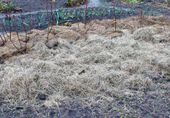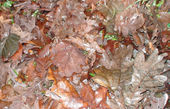Difference between revisions of "Mulching"
| Line 6: | Line 6: | ||
File:Mulching in greenhouse.jpg|A greenhouse prepared for winter. A layer of straw covers all soil and protects the few plants that will stay the winter over. The straw copies the fallen leaves in a forest. Underneath, micro-organisms and little creeping animals will survive and work on the soil to make it healthy and fertile. Weeds are suppressed. | File:Mulching in greenhouse.jpg|A greenhouse prepared for winter. A layer of straw covers all soil and protects the few plants that will stay the winter over. The straw copies the fallen leaves in a forest. Underneath, micro-organisms and little creeping animals will survive and work on the soil to make it healthy and fertile. Weeds are suppressed. | ||
File:Natural mulch - leaves 111223.jpg|Fallen leaves make a natural sheet of mulch. | File:Natural mulch - leaves 111223.jpg|Fallen leaves make a natural sheet of mulch. | ||
| − | File:Soil below a cover of mulch 111223.jpg|In nature, soils are overspread and not bare. This is a soil that is covered with a sheet of mulch. This soil has a crumbly texture, allows water to pass through and is a rich environment for many micro-organism that need oxygen. | + | File:Soil below a cover of mulch 111223.jpg|In nature, soils are overspread and not bare. This is a soil that is covered with a sheet of mulch. This soil has a crumbly texture, allows water to pass through and is a rich environment for many micro-organism that need oxygen. |
| + | File:Garden design - ground covered.jpg|I'm preparing fields for autumn and winter. In an organic garden it is important that the soil is always covered. In this field you see turnips in the back. A [[pumpkin]] in the center, but it did not grow well due to a summer that's too cold and wet. In the front a few [[mullein]] plants that came up wild. Some [[onion]]s, [[thyme]] and [[kale]] at the edges of the field. The circles in the center are formed by another species of [[turnip]]s (Brassica rapa), which are commonly sown as green manure or for animal feed after the harvest of grain. | ||
</gallery> | </gallery> | ||
Revision as of 07:48, 27 December 2011
This page is to prepare and collect information for one or more chapters in the course. --John Eagles 09:34, 22 December 2011 (PST)
Gallery
A greenhouse prepared for winter. A layer of straw covers all soil and protects the few plants that will stay the winter over. The straw copies the fallen leaves in a forest. Underneath, micro-organisms and little creeping animals will survive and work on the soil to make it healthy and fertile. Weeds are suppressed.
I'm preparing fields for autumn and winter. In an organic garden it is important that the soil is always covered. In this field you see turnips in the back. A pumpkin in the center, but it did not grow well due to a summer that's too cold and wet. In the front a few mullein plants that came up wild. Some onions, thyme and kale at the edges of the field. The circles in the center are formed by another species of turnips (Brassica rapa), which are commonly sown as green manure or for animal feed after the harvest of grain.
See also
External links
- Mulching Wikipedia





